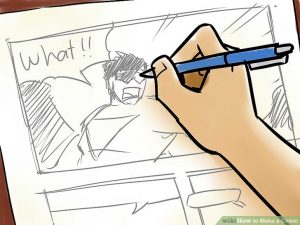Chic Young’s Blondie was one of the most popular and enduring American comic strips. In the early 1950s, Newton Bigelow, then Head of the New York State Department of Mental Hygiene, began to use the characters in his therapeutic sessions. By the standards of his time, Bigelow was an innovatory therapist. For example, he was one of the first therapists in America to introduce group therapy into regular practice.

The specially commissioned comic books that Bigelow and Young developed represent an extremely early example of what comics can do very well: they allowed a pioneering psychotherapist and a major comic artist to convey important ideas about mental health to audiences which at that time might otherwise not have heard of them. Why this approach would ultimately be ignored is not due to their failure, but due to the historical circumstances which I discuss below.
When Bigelow was in charge of the mental health of the city of New York, a vast gamut of concepts and approaches to the mind (and mental health) were beginning to percolate from psychology and psychiatry into the modern American consciousness, at all levels. In particular, this is the period when therapy, at least partially, begins to be democratised in America.
Reading the comics specially produced for the Department of Mental Hygiene, it’s clear that they were intended for a broad adult audience, many of whom may not have had a high educational level. Bigelow had begun by using the standard strips – humorous accounts of a ‘typical’ newlywed American couple – but he progressed to having special comic books commissioned to deal with mental health issues.
Bigelow’s use of Blondie was ground-breaking because he used comic strips to deal with adult issues, such as stress, depression and marital difficulties, at a time when comics were increasingly seen as ‘lowbrow’ or ‘only for kids’. But what is perhaps more significant is that Bigelow commissioned the comics when there was a mounting moral panic about the effect of comics on the moral fibre and mental hygiene of America.
There was special concern for the young, as exemplified by Fredric Wertham’s slightly later book: Seduction of the Innocent. This was a poorly researched, highly selective and histrionic account of the effects of comics on juvenile delinquency. Despite this, particularly by combining homophobia and juvenile delinquency, Seduction of the Innocent tapped into key fears of 1950s America. It provoked a moral panic about comics, and that, in turn, had ongoing, long-lasting consequences for comic book representations of mental health.
Bigelow must have been aware of all of the corrupting dangers claimed for comics at that time. Yet, he chose to use them. Looking at an example, after nearly seventy years, it’s not hard to see why. Rendered in Chic Young’s asylum spring 2015 page 9 homespun style, the narrative isn’t dumbed down; instead, it is amplified by the strip’s simplicity.
In particular, I am struck by the third panel of the final page of ‘Scapegoat’. Dagwood is stressed from his work, and has begun to take it out on his family; and so Blondie has put him to beating a rug. There is no dialogue in this panel, which forcefully indicates the relationship between stress, depression and domestic abuse. (This is not to imply that all domestic abuse is a consequence of work-related stress.) In the next panel Blondie asks: “Feel Better?” Dagwood replies: “Yes dear – I guess all I needed was to get it out of my system.”
The fact that it’s Blondie and Dagwood, American ‘Everyones’, strips away the stereotypes and stigma associated with mental health issues, in much the same way that the TV ‘soaps’ engage with similar issues today. This only goes to show how ground-breaking Bigelow and Young’s use of Blondie was – based on this beginning, one might have imagined a positive future for the depiction of mental health issues in comics.
In reality, while revolutionary at the time, and to modern eyes contemporary, Bigelow and Young’s comic books were an anomaly. Subsequent research showed that Wertham relied on second-hand hearsay and anecdote, and never actually provided much evidence of extreme sex and violence in comics, nor of any effects on juvenile delinquency.
Nevertheless, this was too late to prevent the panic, and like most moral panics, the media anxiety and subsequent censorship of American comics in the 1950s didn’t just confine itself to portrayals of sex and extreme violence. Instead, anything the American authorities, institutions and parents felt uncomfortable with children (and often other adults) reading was censored. And the moral panic that reached its high point with Seduction of the Innocent would sweep consideration of real mental health issues from comics for decades.
The impact of the censorship on the realistic representation of subjects such as mental health was profound. However, that’s not to say that the mad, as distinct from those with mental health issues, disappeared from comics. Fearful of the repercussions of the moral panic exemplified by Wertham’s book, in 1954 the comic publishers agreed to set up the Comics Code Authority (CCA).
The CCA was primarily established to police depictions of sex and gore, but a consequence was that the villainous, the corrupt and the wrongdoer would be increasingly associated with the mentally ill: they became a kind of shorthand for depictions of the evil, crime and wrongdoing that the comics artists were no longer allowed to portray.
For example, it’s arguable that DC Comics (up to and including the Vertigo imprint), have not only not let go of the ‘madness as metaphor’ motif but intensified it: ‘Arkham’, the madhouse and its inmates, runs across many of the publications considered to be amongst their most artistically and commercially significant. The same can be said for Marvel Comics where the ‘mad God’, ‘mad genius’ and ‘mad youth’ are a useful shorthand in any number of stories.
Underground comix, such as Binky Brown meets the Holy Virgin Mary, which focused on Catholicism and OCD, had begun to mine mental health issues back in the 1970s. Marvel has recently published Spiderman has a Secret, in which Peter Parker discusses his experiences of childhood sexual abuse with a child going through the same trauma. This suggests that mainstream American comics are finally opening up to the positive and therapeutic potential of the representation of mental health issues.
However, I feel it’s only in the last decade or so, with the emergence of the smaller imprints and the internet, that comic artists with experiences of mental health have been able to ‘get it out of their system’, and put it down in a medium ideally suited to its representation. While applauding contemporary comic artists, it’s important not to forget pioneers like Bigelow and Young, who more than sixty years ago were attempting to begin a process of positively representing mental health in comics.
